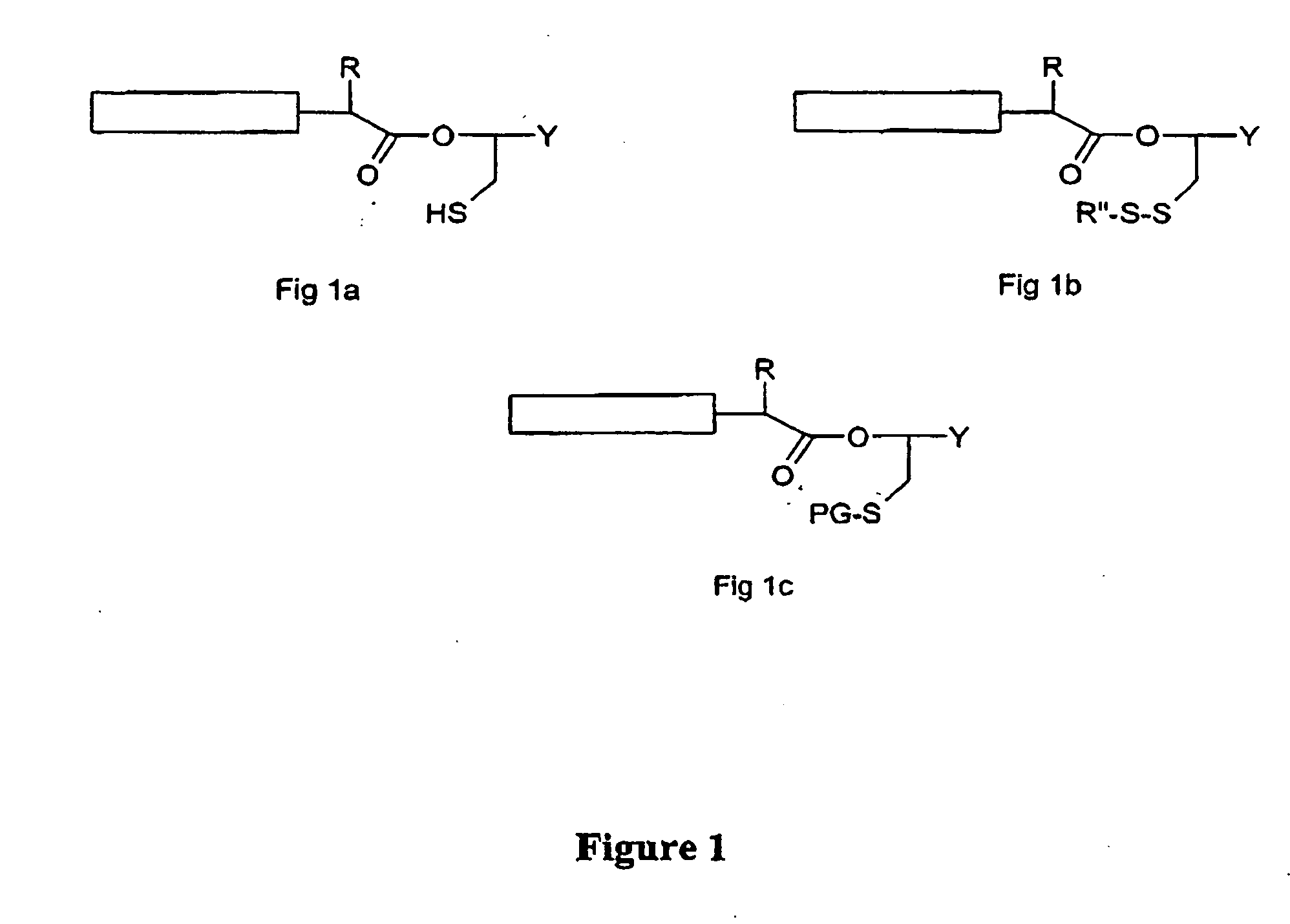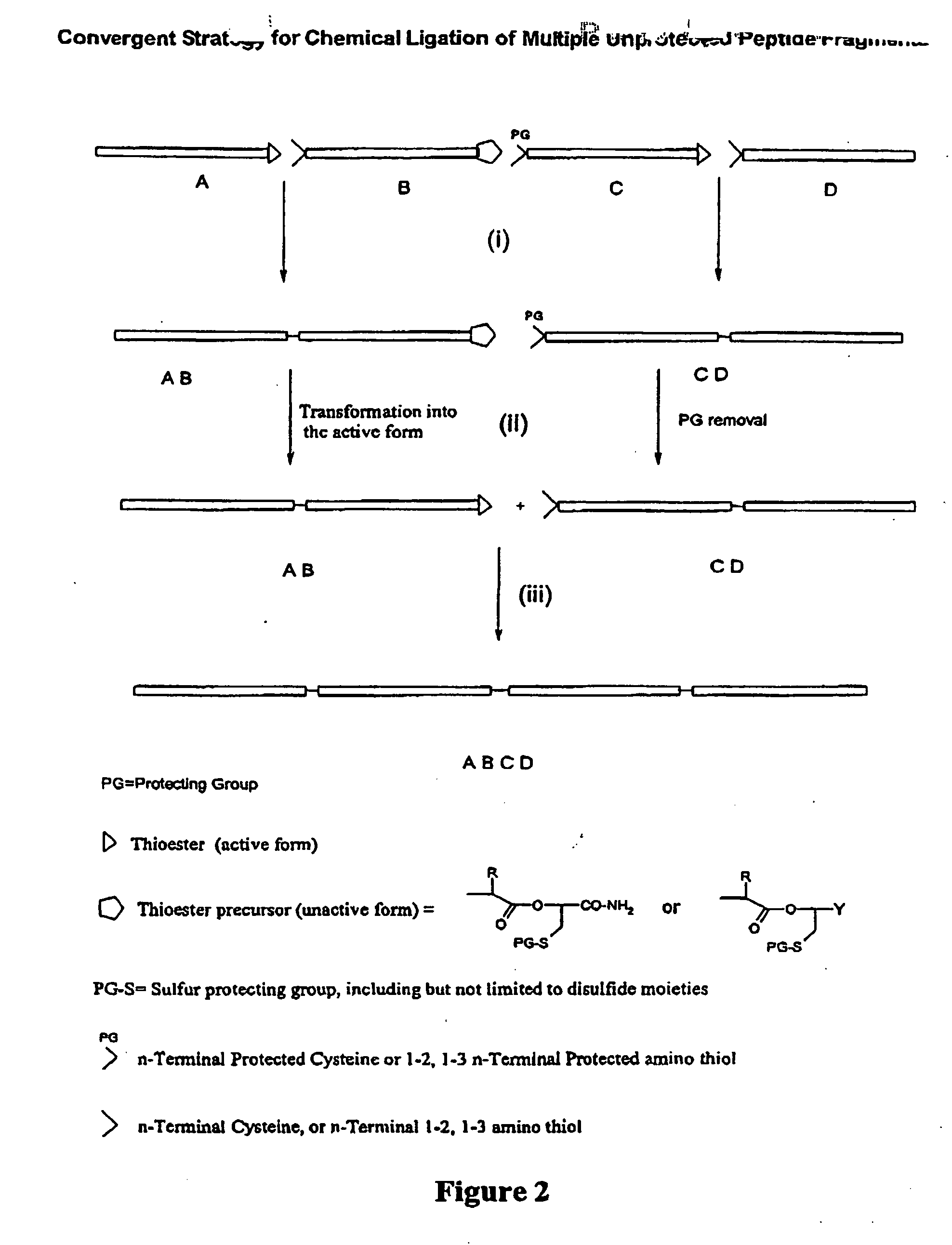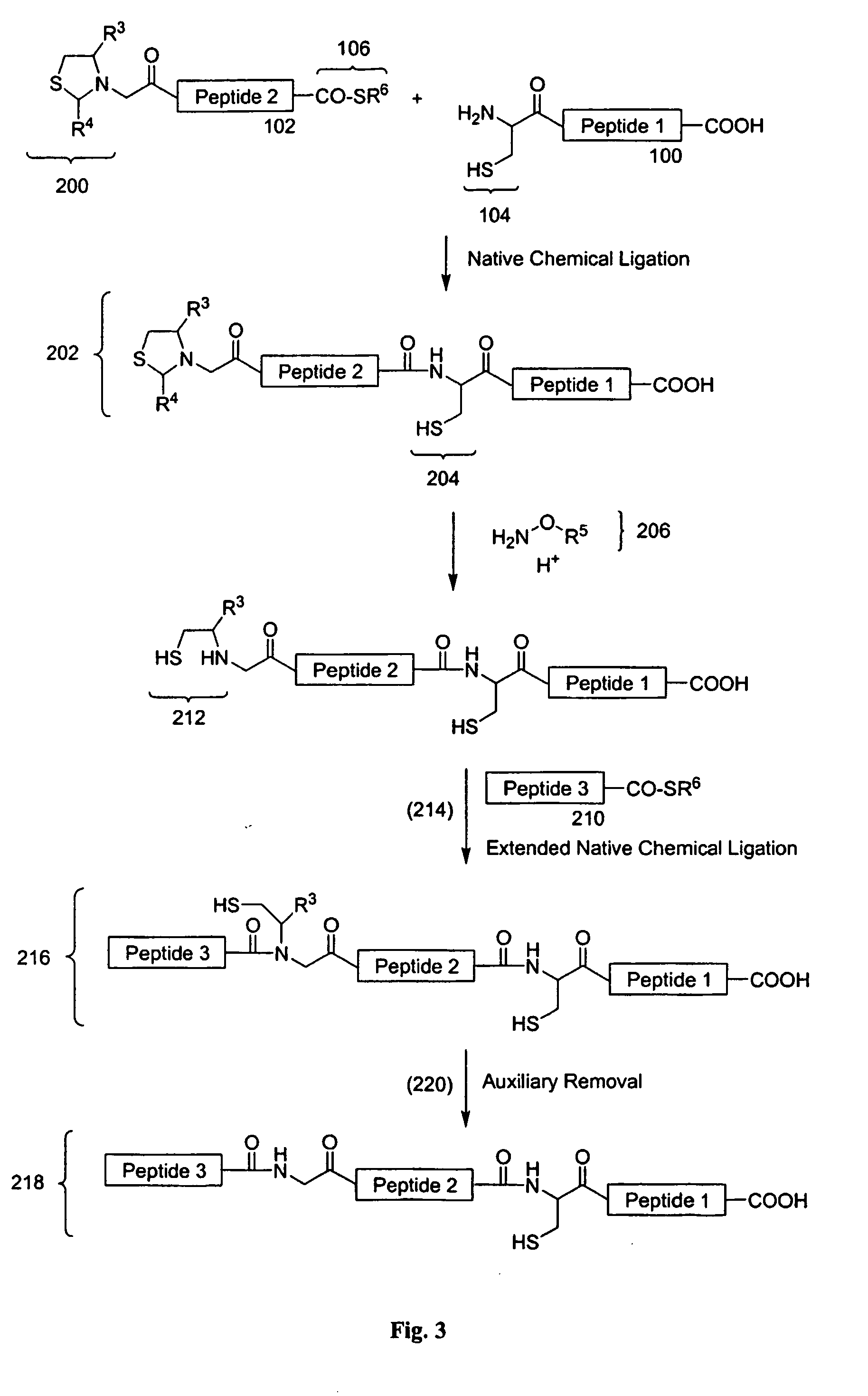Post-cleavage sulfur deprotection for convergent protein synthesis by chemical ligation
a technology of chemical ligation and post-cleavage sulfur, which is applied in the direction of phosphorous compound active ingredients, peptide sources, applications, etc., can solve the problems of difficult to distinguish genes and the sequences that control their expression, and the application of screening a large number of different gene products for determining function is limited, and many important hurdles must be overcom
- Summary
- Abstract
- Description
- Claims
- Application Information
AI Technical Summary
Problems solved by technology
Method used
Image
Examples
example 1
Preparation of LYRAF—O—COCH(CH2—S—S-Pyr)CONH2 (FIG. 10A)
[0110] Rink amide resin (Novabiochem 0.61 mmol / g, 0.1 mmol) was swollen in DMF. After Fmoc removal with a solution 20% of Piperidine in DMF, MmtSCH2CH(OH)COOH (0.5 mmol) was activated with N-hydroxysuccinimide (1.2 eq) and Diisopropylcarbodiimide (1.2 eq.) and coupled to the resin overnight.
[0111] A sample of the resin gave negative ninhydrin reaction. Capping with BocGlyOSu.
[0112] The first Fmoc amino acid (1 mmol) was activated with HBTU / DIEA in the presence of a catalytic amount of DMAP and it was coupled to the resin for 1 hour. A double coupling was necessary. Then the SPPS was performed manually, using 10 excess of each activated Fmoc amino acid and monitored with the ninhydrin test.
[0113] After the final cycle the Fmoc was cleaved and the peptide-resin was washed successively with DMF, DCM, DCM and MeOH and it was dried.
[0114] It was then suspended in a mixture TFA / TIS / H2O:95 / 2.5 / 2.5 containing 5 equivalents of 2.2′...
example 2
Preparation of Chlorolactic Acid—from Beta-Chloroalanine to Chlorolactic Acid (FIGS. 10B, 10C)
[0115] Following a procedure similar that described in Morin et al. Synthesis (1987), 479-480, beta-Chloroalanine (MW=160, 1 g, 6.25 mmol) was dissolved in 20 ml of 1 N aqueous sulfuric acid and the solution was stirred at 4° C. A freshly prepared solution of sodium nitrite (MW=69, 1.36 g, 19.75 mmol) in water (21 ml) was slowly added, dropwise, over 45 minutes, the temperature being maintained at 4° C. After the addition the mixture was left stirring 1 h at 4° C. then, overnight at room temperature.
[0116] Solid sodium hydrogen carbonate was added in order to bring the pH above 2. The solution was then saturated with sodium chloride and extracted with ethyl acetate (6×40 ml) maintaining the pH between 2 and 3 with 1N sulfuric acid. After drying with sodium sulfate the organic phase was evaporated to afford a pale yellow solid. It was washed with hexane and filtered. 550 mg of white crysta...
example 3
Preparation of S-Mmt Lactic Acid (3S-4′Methoxytrityl-2-Hydroxy-Propanoic Acid) By Reaction of Chlorolactic Acid with Mmt-SH (FIGS. 10b. 10c)
[0117] Following a procedure similar to Hope et al. J. Chem. Soc. (C) (1979), 2475-2478), a solution of Chlorolactic acid (MW=125, 1.5 g, 12 mmol) and sodium hydroxide (480 mg, 12 mmol) in hot ethanol (10 ml, 50° C.) was added to a stirred solution of 4-Methoxymethyl mercaptan (MW=306.4, 3.68 g, 12 mmol) and sodium hydroxide (480 mg, 12 mmol) in hot ethanol (10 ml, 50° C.). The volume was brought up to 60 ml with ethanol. The mixture was heated under reflux for 8 hours, then it was left stirring at room temperature overnight. The solvent was evaporated, the solid residue was dissolved in water and the pH was brought to =4. The mixture was extracted with ethyl acetate (4×50 ml). The combined organic extracts were dried over magnesium sulfate and the solvent was removed under reduced pressure to give 4.52 g of an orange oil which solidified at ro...
PUM
| Property | Measurement | Unit |
|---|---|---|
| pH | aaaaa | aaaaa |
| volume | aaaaa | aaaaa |
| pH | aaaaa | aaaaa |
Abstract
Description
Claims
Application Information
 Login to View More
Login to View More - R&D
- Intellectual Property
- Life Sciences
- Materials
- Tech Scout
- Unparalleled Data Quality
- Higher Quality Content
- 60% Fewer Hallucinations
Browse by: Latest US Patents, China's latest patents, Technical Efficacy Thesaurus, Application Domain, Technology Topic, Popular Technical Reports.
© 2025 PatSnap. All rights reserved.Legal|Privacy policy|Modern Slavery Act Transparency Statement|Sitemap|About US| Contact US: help@patsnap.com



